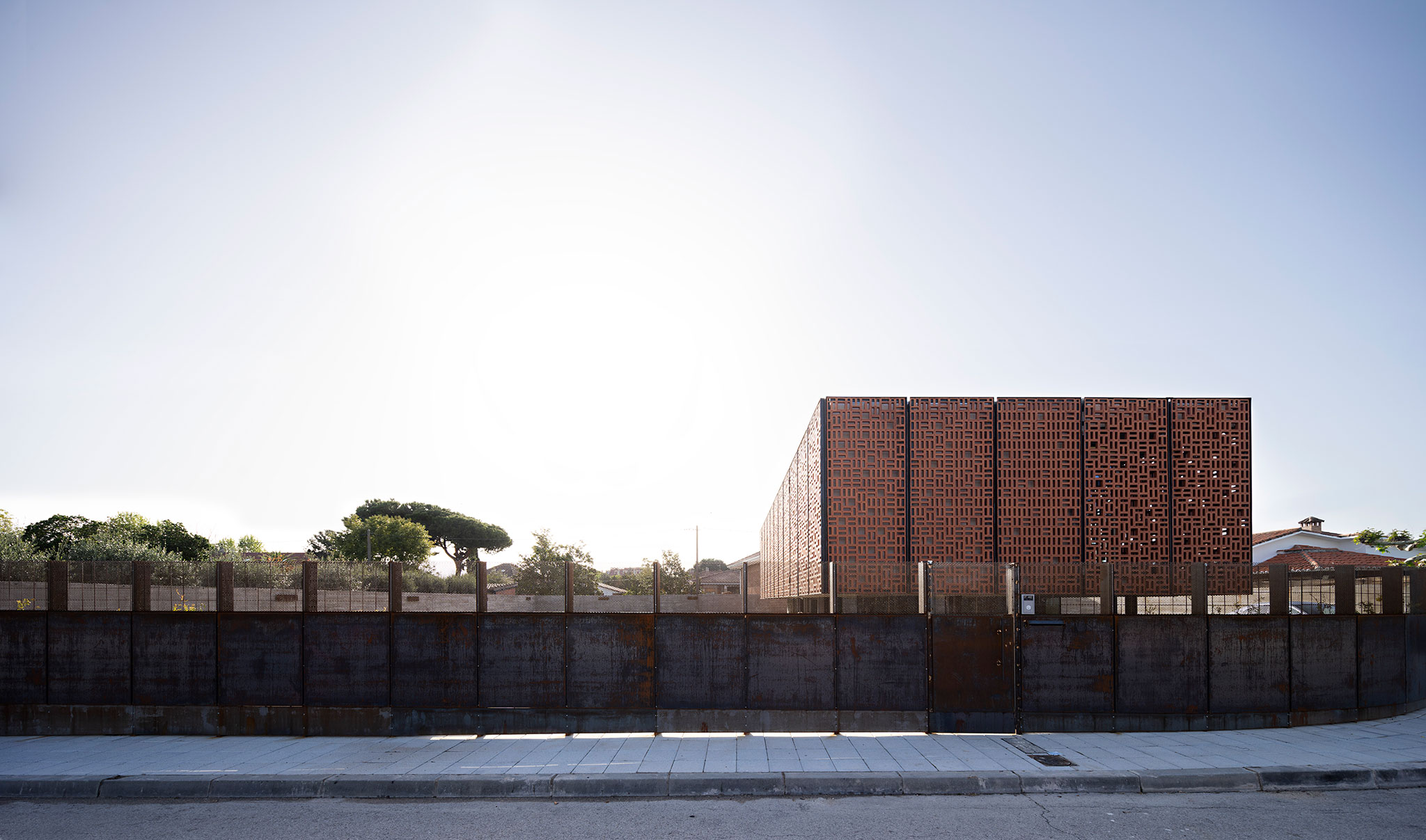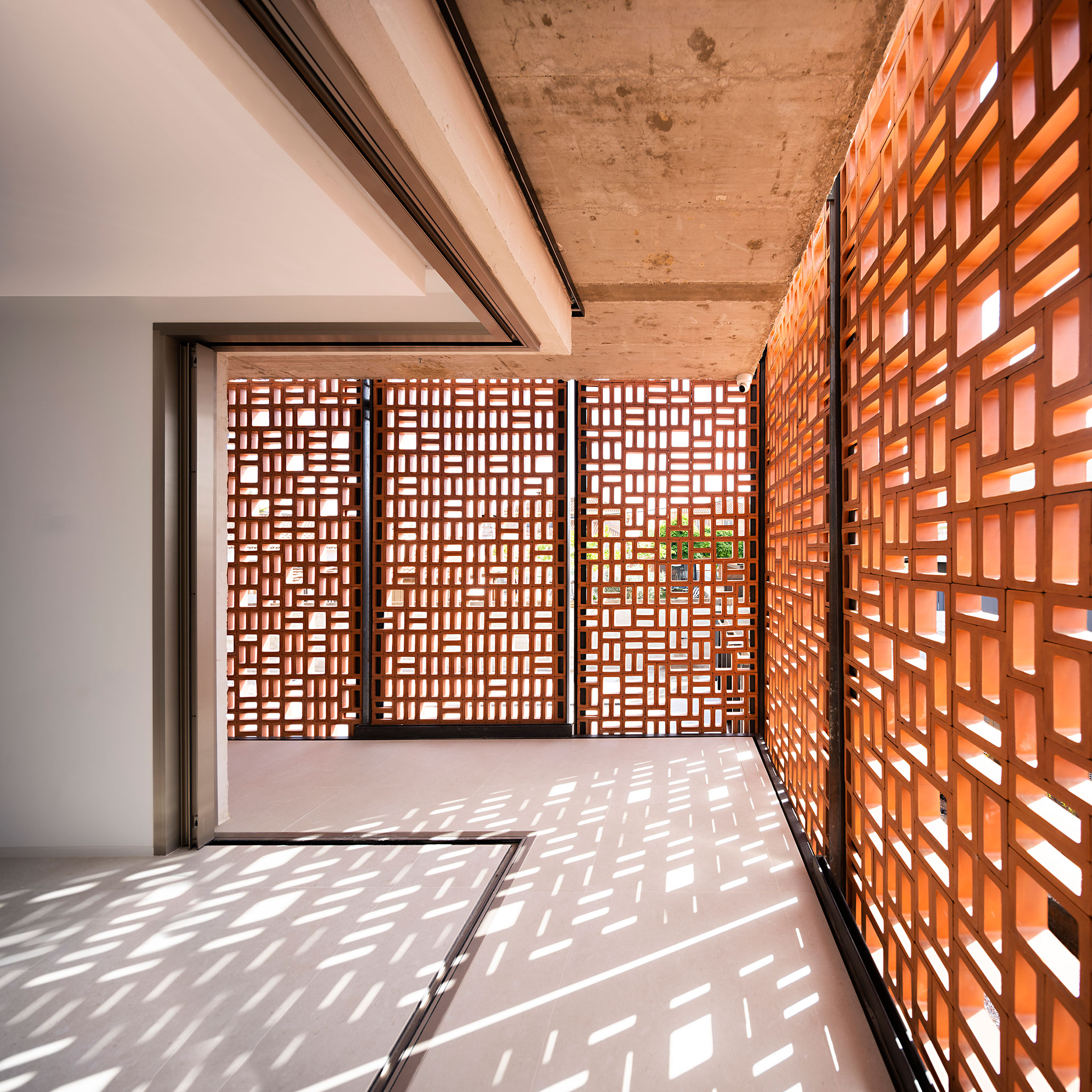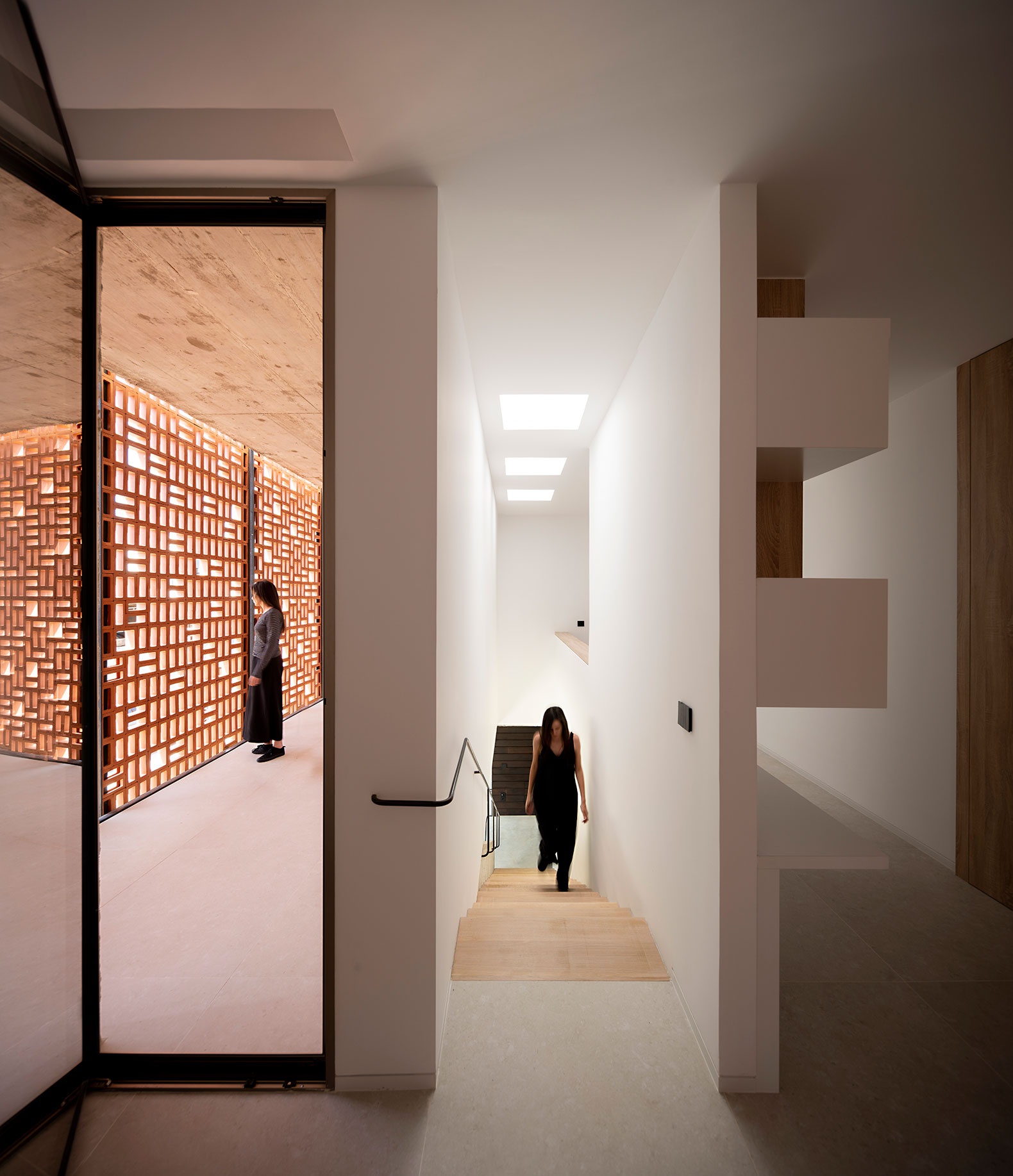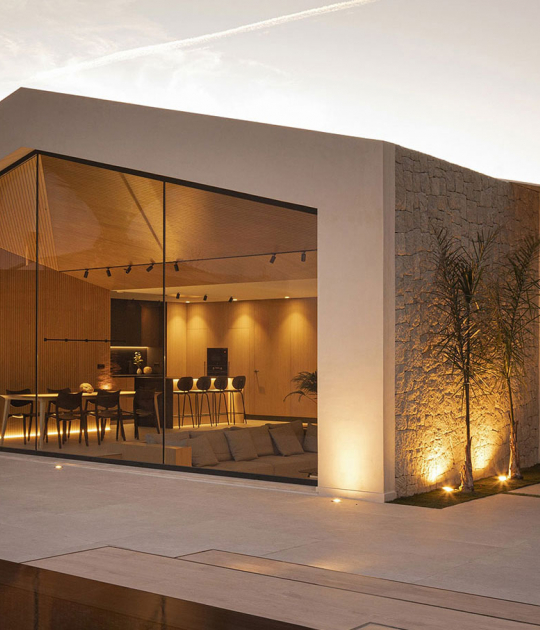In relation to the construction materials used, it is worth highlighting the dialogue between ceramics and the use of exposed reinforced concrete in walls and floors, and the load-bearing elements of the structure. In contrast to its massiveness, a latticework is created through the repetition of two ceramic modules, one square and the other rectangular. The latticework acts as a solar filter, also providing an interesting degree of privacy to the home.


Lantern House by MUKA arquitectura. Photograph by Javier Callejas
Description of project by MUKA arquitectura
The house, as well as being our refuge, must relate to the city and produce new encounters with the urban context in which it is inserted. But, at the same time, it must manifest a certain enigmatic condition of what goes on behind its walls and enclosures.
How much the activity in the house should be glimpsed from the street and how much the functioning of the house should defend its most private condition from the rest of the neighbors is a question to which this project provides a rereading.
In the Farol House, the questions of how the piece should be inserted into the municipality and how the interactions between the users and the dwelling should take place have been resolved through a traditional material, ceramics. While human life, in its essence, in its basic needs, has not changed excessively over the last few centuries, social issues have changed substantially towards greater complexity. The result of these new conditioning factors offers, as a formal result and in contrast to our contemporary domestic way of life, a simple box, with defined edges and limits, made of clay, suspended, which organizes the plot, the uses, the privacy of its users and, above all, the light.
The tension between the clay and the void allows the light to vibrate and be modeled. As happens with sound in wind instruments, where the air passes through the holes to modulate the melodies, the red material extracted from the earth and cooked by the fire of our ancestors offers experiences to the user through the link between man and matter and expands the qualities of the house that links us to the deepest part of the human being. Realized in collaboration with architect Eduardo Mediero and architecture student Evan Parness.
The house and the city.
The house, the refuge of each one of us, must relate to the city and produce new encounters with the urban context in which it is inserted. But, at the same time, it must manifest a certain enigmatic condition of what goes on behind its walls and enclosures that protects its users both visually and functionally.
How much the activity in the house should be glimpsed from the street and how much the functioning of the house should defend its most private condition from the rest of the neighbors is a question that always deserves a new rereading.
In the Farol House, the questions of how the piece should be inserted into the municipality and how the relations between the users and the house should be produced through its uses have been the main driving force behind the search for a solution for this proposal.
The single-family dwelling, owing to its domestic size, is capable of creating objects of formal clarity that in other larger-scale architectures is less evident. This condition must be taken advantage of to order the streets of low-density residential areas. Otherwise, pieces of confused geometry begin to emerge, which added to an erroneous choice of materials produces a juxtaposition of textures incoherent from any urban logic and unnecessary noise from the resounding silence of the form.
The transversal position of the house on the alignment of Jilgueros street offers a visual accommodation of the piece during the approach; a more pleasant and less aggressive presence than implantation aligned with the street. This foreshortened urban presence also opens up the surrounding landscape and gives the city -and ultimately its users- the possibility of perceiving the vegetation hidden in the backyards of the adjoining dwellings. The magnificent olive and pine trees on the private plots are a better illustration of the garden-city character of this neighborhood than any nearby building. The gentle quality of the sinuous line separating the sky from the treetops is emphasized by the emphatic geometric condition of the ceramic prism. Its straight lines, outlining the sky as cleanly and precisely as the incision produced by a sharp scalpel blade, form a dialogue between what is anchored to the ground and what levitates and belongs to the universe.

Lantern House by MUKA arquitectura. Photograph by Javier Callejas
The ceramic box.
The straight pediment suggested by the ceramic lattice ends the portico on the ground floor in contact with the sky. It suggests the capacity for abstraction similar to that of a Greek temple through its geometry and play of lines. If in classical Greece its triangular resolution was necessary due to the obligatory nature of the sloping roofs, today this same gable can be straight, since we can solve it with flat roofs. The relevance of this classical element in which entire exciting scenes of a well-known myth were told, such as the birth of Athena in the Parthenon, means that the Lantern House also tells the daily and exciting vibration of the light as it passes through the ceramic geometry. The Lantern House aims to tell the story of the sun, changing with the light that reaches us each year. Three hundred and sixty-five episodes are superimposed, one after the other, like the skins of a bulb in the earth, which complete the meaning of this piece.
Contact with the ground.
The ground, on which the ceramic volume rests, is manipulated through a double operation. Firstly, part of the ground is excavated to partially re-sink the ground floor, which houses the day rooms such as the living room, dining room, and kitchen, connected to the outside through large panes of glass. This produces a horizontal visual relationship with the ground plane that is closer to the height and static position of its users and underlines their privacy by creating diagonal visual relationships that distance their position from that of the neighboring dwellings. Secondly, the broken perimeter resulting from this subtraction presents a more complex reading than the upper volume by accommodating all the necessary accidents that orbit around the house, such as the swimming pool, small terraced areas, several access staircases, and connections with the rest of the garden and car park and other connections with machine rooms. Meanwhile, between the limit of the plot and the perforated glass, a clean horizontal plane flooded with pebble gravel emphasizes the formal identity of the entire project operation. The re-sinking of the piece also emphasizes the weight of the ceramic volume as other architectures, and other masters, have shown us before. The limit of the air-conditioned area of the ground-floor dwelling is resolved mainly by three elements: large windows protected from direct sunlight by the overhang of the upper volume, a box that forms the bamboo wood access as a chamber or intermediate space between the interior and the exterior, and a concrete wall or "U"-shaped rib at the back of the floor that contains the living area. The pillars supporting the upper floor are positioned free of any encounter with other materials or enclosures and are even split into a kind of composite pillar to allow air to pass through it and the lightness of the piece to contrast with the massive nature of the ceramic piece. In this way and from the perception of the longitudinal elevation, the supports of the upper box are dematerialized from the concrete walls to the pillars and from the bottom of the plot to Jilgueros street.
Lower level. Horizontal relationship.
The ground floor consists of two horizontal planes of exposed concrete. Both the paving and the ceiling have been executed as elements that maintain a relationship of tension between them, understood as a functional sandwich where most of the activity of the house takes place. This solution emphasizes the horizontal visuals with the rest of the plot, leaving the adjoining dwellings out of visual control and thus increasing privacy in the home.
The solution of large floor-to-ceiling sliding windows allows the interior and exterior to be linked, blurring their limits. The swimming pool and the rest of the activities on the plot become part of everyday life and the ceramic lattice works as an urban curtain that protects the house from the views of the adjoining neighbors.
There is a single diagonal element inside the house, also built in concrete, which connects the lower world with the upper one: the staircase slab. This inclined plane allows the kitchen and the rest of the furniture to be placed behind it, closing towards one of the sides (north) and opening up towards the south. The stair tread is resolved as a wooden skin in the manner of a carpet that serves as a transition between the concrete flooring on the ground floor and the ceramic flooring on the upper floor.

Lantern House by MUKA arquitectura. Photograph by Javier Callejas
Upper level. The clay that moulds the light.
The upper floor has been resolved with a ceramic envelope on all its façades, giving the project a sense of clarity and rotundity. The constructive simplicity developed - and patented - in this project resolves a complex interior world. The ceramic skin approaches and separates from the enclosure of the rooms to achieve a world of interstitial situations where the lattice behaves in different ways. As opposed to an element attached to the opaque enclosure that protects it from the direct sunlight, there are other areas where the separates sufficiently to form a gallery and ONE additional room in the house. In this way, the boundary between inside and outside is blurred once again to enter a world of intermediate situations that add richness to the experience in the house. The play of light and shadow and the perception of the passing of the hours of the day reaffirm our relationship with biometry, with our part of the material, biological self. But, at the same time, the kindness with which the light penetrates the rooms gives us a spiritual condition that completes our experience of life.
The most important room on the upper floor is the master bedroom, where the space is emphasized through the corner, free from the interior enclosure, and the ceramics come to the fore. In other rooms, there are complementary relationships, such as through the windows with a disproportionate scale, like large, wide-open, attentive eyes, and through gates that allow access to the ceramic gallery.
Play of light and shadow.
The light hits the walls of the terracotta pieces and is reflected and floods the interior of the rooms. The natural shade of the earthenware, of the perforated reddish ceramic, manages not only to shape the light but also to give a warmer tone to the interior of the rooms. The more orangey tone of the light distinguishes the inside and the outside, the light that comes directly from the sun, and the domesticated light, caressed by the material and then filtered through its interstices to serve the users.
In any architecture, the window allows us sufficient natural light inside. At the same time, it creates a link, a special relationship with the outside. It will also depend on its size and position to give a unique quality to that space. Filtering light through matter, in the same way, that we strain water through a coffee filter, allows us to color and make light vibrate. We talk about a servant and served spaces, but perhaps we should also talk about the servant and served light when it is filtered through matter. Depending on the season, the permeable nature of this construction system allows the sun's rays either to protect the house from direct solar radiation or, on the contrary, to penetrate the interior, flooding the floor with a changing play of light and shadow.
Light and massive. An inhabited lantern.
The perception of the lattice from the outside is also changing. Depending on the time of day, the reflections of light on the ceramic establish very different readings of the piece through the material. An exacerbated opacity, a set of reflections, tonalities, and textures that cover a wide range of nuances, as well as the capacity for transparency that it possesses at nightfall when the light from the interior is projected towards the exterior, manifesting an endless number of possibilities and variables that, once again, turn this simple solution into a complex house. An inhabited lantern.
The lattice, besides being conceived as a solar filter owing to Madrid's extreme climate and its harsh afternoon sun on summer afternoons, has the quality of concealing its users from the outside. The ceramic provides an additional degree of privacy to the upper floor without sacrificing light. Its execution through frames hung from the edges of the slabs dematerializes its presence from the inside, where horizontal light cracks at the point of contact between the upper and lower planes show the ceramic's desire to float, to levitate, in the play proposed by the light.
Ceramic canvas. The technique.
The lattice is made up of two ceramic modules: one square and the other rectangular, half-sided so that the sum of two half-pieces completes the larger format. The union between the pieces is produced using a dry joint that is imperceptible to the human eye so that the traditional bonding mortar typical of the union between two ceramic pieces disappears. In this way, the ceramic pieces are stacked, like the ancient ashlars in the mass of Greek temples, without mortar joints. They are framed in a metal frame like paintings, like ceramic canvases, as if a painter had sketched different variants of the same composition. Although the Romans taught us to use mortar to join two pieces of brick, the capacity of today's technique allows the union to disappear, producing friction, or tension, between the material, the vibration of which is transferred to the tension of the piece placed in the urban landscape.





























































